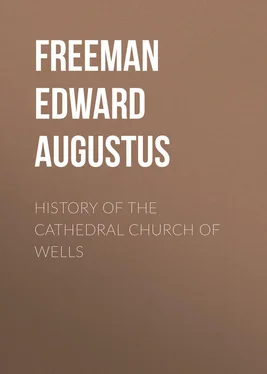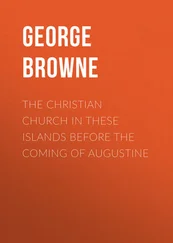Edward Freeman - History of the Cathedral Church of Wells
Здесь есть возможность читать онлайн «Edward Freeman - History of the Cathedral Church of Wells» — ознакомительный отрывок электронной книги совершенно бесплатно, а после прочтения отрывка купить полную версию. В некоторых случаях можно слушать аудио, скачать через торрент в формате fb2 и присутствует краткое содержание. Жанр: foreign_antique, foreign_prose, на английском языке. Описание произведения, (предисловие) а так же отзывы посетителей доступны на портале библиотеки ЛибКат.
- Название:History of the Cathedral Church of Wells
- Автор:
- Жанр:
- Год:неизвестен
- ISBN:нет данных
- Рейтинг книги:4 / 5. Голосов: 1
-
Избранное:Добавить в избранное
- Отзывы:
-
Ваша оценка:
- 80
- 1
- 2
- 3
- 4
- 5
History of the Cathedral Church of Wells: краткое содержание, описание и аннотация
Предлагаем к чтению аннотацию, описание, краткое содержание или предисловие (зависит от того, что написал сам автор книги «History of the Cathedral Church of Wells»). Если вы не нашли необходимую информацию о книге — напишите в комментариях, мы постараемся отыскать её.
History of the Cathedral Church of Wells — читать онлайн ознакомительный отрывок
Ниже представлен текст книги, разбитый по страницам. Система сохранения места последней прочитанной страницы, позволяет с удобством читать онлайн бесплатно книгу «History of the Cathedral Church of Wells», без необходимости каждый раз заново искать на чём Вы остановились. Поставьте закладку, и сможете в любой момент перейти на страницу, на которой закончили чтение.
Интервал:
Закладка:
2 2 I refer to the debate in the House of Commons on the Scotch Reform Bill of 1868, when it was discussed whether Wells or Evesham should be disfranchised. "Sir Lawrence Palk argued on behalf of Wells that it is 'a cathedral city of great antiquity.' This appeal on behalf of the seculars was at once met by the monastic zeal of Sir John Pakington, who daringly answered, that if Evesham 'cannot boast of a cathedral, it can of one of the most beautiful abbeys in England.' We should be sorry to suspect the good town of Evesham of any Anabaptist tendencies, but it is certain that, if it makes the boast which the member for Droitwich puts into its mouth, it belongs to the class of those who do falsely boast … Mr. Gladstone had never been at Evesham; we know of no particular call of duty likely to take him there; but Sir John Pakington, a Worcestershire man, must surely have visited a borough in his own shire. How then about the beautiful abbey, one of the most beautiful in England? Any one who has been both at Wells and at Evesham must know that Wells Cathedral is still standing, while Evesham Abbey, saving its bell-tower and a small piece of wall, has long ceased to exist. But one might ask both disputants whether Sir Lawrence Palk, in his zeal for cathedrals, would enfranchise Ely and Saint David's – whether Sir John Pakington, in his zeal for abbeys, would restore Saint Alban's and enfranchise Romsey." — Saturday Review , July 11, 1868.
The whole interest, then, of this city is ecclesiastical; but its ecclesiastical interest in one point of view surpasses that of every church in England, – I am strongly tempted to say, every church in Europe. The traveller who comes down the hill from Shepton Mallet looks down, as he draws near the city, on a group of buildings which, as far as I know, has no rival either in our own island or beyond the sea. To most of these objects, taken singly, it would be easy to find rivals which would equal or surpass them. The church itself, seen even from that most favourable point of view, cannot, from mere lack of bulk, hold its ground against the soaring apse of Amiens, or against the windows ranging, tier above tier, in the mighty eastern gable of Ely. The cloister cannot measure itself with Gloucester or Salisbury; the chapter-house lacks the soaring roofs of York and Lincoln; the palace itself finds its rival in the ruined pile of Saint David's. The peculiar charm and glory of Wells lies in the union and harmonious grouping of all. The church does not stand alone; it is neither crowded by incongruous buildings, nor yet isolated from those buildings which are its natural and necessary complement. Palace, cloister, Lady chapel, choir, chapter-house, all join to form one indivisible whole. The series goes on uninterruptedly along that unique bridge which by a marvel of ingenuity connects the church itself with the most perfect of buildings of its own class, the matchless Vicars' close. Scattered around we see here and there an ancient house, its gable, its window, or its turret falling in with the style and group of greater buildings, and bearing its part in producing the general harmony of all. The whole history of the place is legibly written on that matchless group of buildings. If we could fancy an ecclesiastical historian to have dropped from the clouds, the aspect of the place would at once tell him that he was looking on an English cathedral church, on a cathedral church which had always been served by secular canons, on a church of secular canons which had preserved its ancient buildings and ancient arrangements more perfectly than any other in the island. It is to the history of that great institution, alike in its fabric and its foundation, that I call your attention in the present course of lectures. And, taking Wells as my text, I purpose to compare our own church, alike in its fabric and its foundation, with other churches of the same class. The subject naturally falls into three divisions. I purpose to devote three discourses of moderate length to the early, the mediæval, and the modern history of the Church of Wells.
For a subject like that which I have chosen is obviously one which may be looked at from various points of view. A cathedral church like ours is not only a material fabric, a work of architecture; it is also an ecclesiastical institution, an establishment founded for the benefit of our Church and nation, and which has played its part, whatever that part may have been, in the general history of the country. I purpose to look at it in both aspects, aspects either of which is very imperfectly treated if it wholly shuts out the other. But I do not purpose to treat either branch of the subject in any very minute detail. A minute architectural or antiquarian memoir has its value, but it is not at all suited to a popular lecture. A minute architectural exposition, if it is to be intelligible, must be given on the spot. A minute antiquarian memoir, crowded with names and dates, is often very profitable when printed, but it is not at all suited to be read out to a general audience. Moreover I should be very sorry to trespass on the province of one to whose minute knowledge of local history I can make no claim. My object is different. I wish to treat the history of Wells Cathedral, both as a building and as an institution, in a more general, in what I may call a comparative, way. I wish to dwell on the position of our own church as one of a class, to point out how it stands among other buildings and other institutions of its own class, and to trace out its connexion with the general history of the Kingdom and Church of England.
Читать дальшеИнтервал:
Закладка:
Похожие книги на «History of the Cathedral Church of Wells»
Представляем Вашему вниманию похожие книги на «History of the Cathedral Church of Wells» списком для выбора. Мы отобрали схожую по названию и смыслу литературу в надежде предоставить читателям больше вариантов отыскать новые, интересные, ещё непрочитанные произведения.
Обсуждение, отзывы о книге «History of the Cathedral Church of Wells» и просто собственные мнения читателей. Оставьте ваши комментарии, напишите, что Вы думаете о произведении, его смысле или главных героях. Укажите что конкретно понравилось, а что нет, и почему Вы так считаете.












